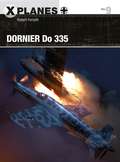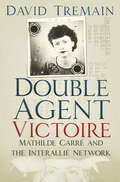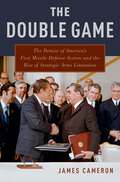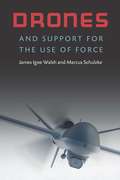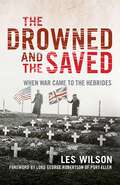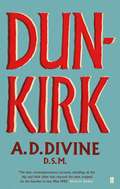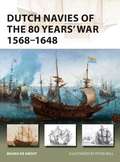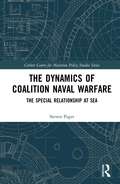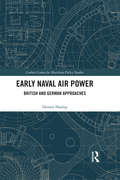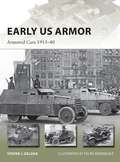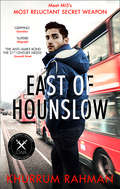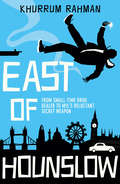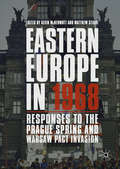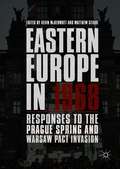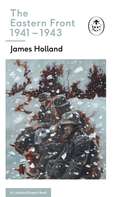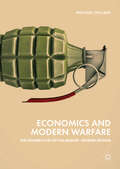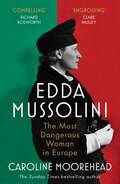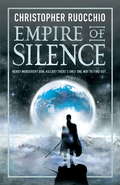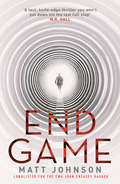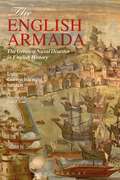- Table View
- List View
Dornier Do 335 (X-Planes #9)
by Robert Forsyth Adam Tooby Wiek Luijken Simon SchatzThe Dornier Do 335 was conceived as a high-speed, all-weather fighter, and represented the pinnacle of piston-engined aircraft design. The Do 335 was a big aircraft, weighing just over 10,000kg when laden with fuel, equipment, and pilot, yet powered by two Daimler-Benz DB 603 engines, it was capable of reaching a maximum speed of 750km/h at 6400 meters, making it the fastest piston engine aircraft produced in Germany during World War II.Some forty aircraft were built between late 1943 and the end of the war, and it was intended to deploy the type as a day fighter, bomber, night fighter, bad weather interceptor, and reconnaissance aircraft, all of which were intended to incorporate the latest armament, bomb sights, communications, and radar equipment, as well as an ejector seat. Featuring archive photography and specially commissioned artwork, this is the full story of the aircraft that the Luftwaffe hoped would turn the tide of the war.
Double Agent Victoire: Mathilde Carré and the Interallié Network
by David TremainMathilde Carré, notoriously known as La Chatte, was remarkable for all the wrong reasons. Like most spies she was temperamental, scheming and manipulative – but she was also treacherous. A dangerous mix, especially when combined with her infamous history of love affairs – on both sides. Her acts of treachery were almost unprecedented in the history of intelligence, yet her involvement in the ‘Interallié affair’ has only warranted a brief mention in the accounts of special operations in France during the Second World War. But what motivated her to betray more than 100 members of the Interallié network, the largest spy network in France? Was she the only guilty party, or were others equally as culpable? Using previously unpublished material from MI5 files, Double Agent Victoire explores the events that led to her betrayal, who may have ‘cast the first stone’, and their motivations, as well as how the lives and careers of those involved were affected. It reveals a story full of intrigue, sex, betrayal and double-dealing, involving a rich cast including members of the French Resistance, German Abwehr and British Intelligence.
The Double Game: The Demise of America's First Missile Defense System and the Rise of Strategic Arms Limitation
by James CameronHow did the United States move from a position of nuclear superiority over the Soviet Union at the beginning of the 1960s to one of nuclear parity under the doctrine of mutual assured destruction in 1972? Drawing on declassified records of conversations three presidents had with their most trusted advisors, James Cameron offers an original answer to this question. John F. Kennedy, Lyndon Johnson, and Richard Nixon struggled to reconcile their personal convictions about the nuclear arms race with the views of the public and Congress. In doing so they engaged in a double game, hiding their true beliefs behind a façade of strategic language while grappling in private with the complex realities of the nuclear age. Cameron shows how, despite reservations about the nuclear buildup, Kennedy and Johnson pushed ahead with an anti-ballistic missile (ABM) system for the United States, fearing the domestic political consequences of scrapping both the system and the popular doctrine of strategic superiority that underpinned it. By contrast, the abrupt decline in US public and congressional support in 1969 forced Nixon to give up America's first ABM and the US lead in offensive ballistic missiles through agreements with the Soviet Union, despite his conviction that the US needed a nuclear edge to maintain the security of the West. By placing this dynamic at the center of the story, The Double Game provides a new overarching interpretation of this pivotal period in the development of US nuclear policy and a window onto current debates over nuclear superiority, deterrence, and the future of American grand strategy.
Drones and Support for the Use of Force
by James Igoe Walsh Marcus SchulzkeCombat drones are transforming attitudes about the use of military force. Military casualties and the costs of conflict sap public support for war and for political and military leaders. Combat drones offer an unprecedented ability to reduce these costs by increasing accuracy, reducing the risks to civilians, and protecting military personnel from harm. These advantages should make drone strikes more popular than operations involving ground troops. Yet many critics believe drone warfare will make political leaders too willing to authorize wars, weakening constraints on the use of force. Because combat drones are relatively new, these arguments have been based on anecdotes, a handful of public opinion polls, or theoretical speculation. Drones and Support for the Use of Force uses experimental research to analyze the effects of combat drones on Americans’ support for the use of force. The authors’ findings—that drones have had important but nuanced effects on support for the use of force—have implications for democratic control of military action and civil-military relations and provide insight into how the proliferation of military technologies influences foreign policy.
The Drowned and the Saved: – Saltire Society History Book of The Year 2018
by Les Wilson'Next morning at about 6 o’clock my mother wakened us to say there had been a shipwreck and bodies were being washed ashore. My father had gone with others to look for survivors ... I don’t think any survivors came in at Port Ellen but bodies did.'The loss of two British ships crammed with American soldiers bound for the trenches of the First World War brought the devastation of war directly to the shores of the Scottish island of Islay.The sinking of the troopship Tuscania by a German U-Boat on 5 February 1918 was the first major loss of US troops in in the war. Eight months after the people of Islay had buried more than 200 Tuscania dead, the armed merchant cruiser Otranto collided with another troopship during a terrible storm. Despite a valiant rescue attempt by HMS Mounsay, the Otranto drifted towards Islay, hit a reef, throwing 600 men into the water. Just 19 survived; the rest were drowned or crushed by the wreckage.Based on the harrowing personal recollection of survivors and rescuers, newspaper reports and original research, Les Wilson tells the story of these terrible events, painting a vivid picture which also pays tribute to the astonishing bravery of the islanders, who risked their lives pulling men from the sea, caring for survivors and burying the dead.
Dunkirk
by A.D. Divine O.B.E.This is the story of Dunkirk and of the men who planned it (insofar as it was planned) and of the men who carried it out, and of their ships. Mr Divine, who was himself with the small boats, writes with the authority of direct knowledge. He had the assistance of the men who were intimately concerned with planning and organising the operation. This is the true story of Dunkirk from its almost nebulous beginnings to the astonishing triumph of its end.
Dutch Navies of the 80 Years' War 1568–1648 (New Vanguard)
by Peter Bull Bouko De GrootThe tiny new state of the United Provinces of the Netherlands won its independence from the mighty Spanish empire by fighting and winning the Eighty Years' War, from 1568 and 1648. In this long conflict, warfare on water played a much bigger role in determining the ultimate victor. On the high seas the fleet carved out a new empire, growing national income to such levels that it could continue the costly war for independence. Yet it was in coastal and inland waters that the most decisive battles were fought. Arguably the most decisive Spanish siege (Leiden, 1574) was broken by a fleet sailing to the rescue across flooded polders, and the battle of Nieuwpoort in 1600, the largest successful invasion fleet before World War II, was one of the most decisive battle in western history. Using detailed full colour artwork, this book shows how the Dutch navies fought worldwide in their war of independence, from Brazil to Indonesia, and from the Low Countries to Angola.
The Dynamics of Coalition Naval Warfare: The Special Relationship at Sea (Corbett Centre for Maritime Policy Studies Series)
by Steven PagetThis book examines the dynamics of coalition naval operations. Since the end of the Second World War, few nations possess the capacity for large scale, sustained and independent naval operations; and even those that do, such as the USA, often find it economically, militarily and politically expedient to act multilaterally. As such, coalition naval operations increasingly became the norm throughout the twentieth-century, and there is little sign of this abating in the twenty-first. Multinational operations provide a number of benefits, but they also present a number of challenges. Examining the dynamics of coalition operations involving the Royal Navy (RN), Royal Australian Navy (RAN) and the United States Navy (USN) during the Korean War, Vietnam War and the Iraq War, this book provides a broad overview of naval interoperability between the three navies. Using the naval gunfire support (NGS) capability as a lens through which to analyse operations, the study explores a diverse range of issues, including: command and control, communications, equipment standardisation, intelligence, logistics, planning, rules of engagement, tactics, techniques and procedures and training. Approaching the subject through both historical and contemporary perspectives not only provides a unique assessment of the variation in the effectiveness of interoperability over time, but also offers a platform for better understanding and enhancing the performance of future coalition naval operations. Based on extensive archival research in Australia, the UK and the US, as well as wide-ranging interviews, this book sheds new light on the dynamics of conducting coalition operations. This book will be of great interest to students of naval history, strategic studies, sea power, maritime security, military studies, and IR in general.
The Dynamics of Coalition Naval Warfare: The Special Relationship at Sea (Corbett Centre for Maritime Policy Studies Series)
by Steven PagetThis book examines the dynamics of coalition naval operations. Since the end of the Second World War, few nations possess the capacity for large scale, sustained and independent naval operations; and even those that do, such as the USA, often find it economically, militarily and politically expedient to act multilaterally. As such, coalition naval operations increasingly became the norm throughout the twentieth-century, and there is little sign of this abating in the twenty-first. Multinational operations provide a number of benefits, but they also present a number of challenges. Examining the dynamics of coalition operations involving the Royal Navy (RN), Royal Australian Navy (RAN) and the United States Navy (USN) during the Korean War, Vietnam War and the Iraq War, this book provides a broad overview of naval interoperability between the three navies. Using the naval gunfire support (NGS) capability as a lens through which to analyse operations, the study explores a diverse range of issues, including: command and control, communications, equipment standardisation, intelligence, logistics, planning, rules of engagement, tactics, techniques and procedures and training. Approaching the subject through both historical and contemporary perspectives not only provides a unique assessment of the variation in the effectiveness of interoperability over time, but also offers a platform for better understanding and enhancing the performance of future coalition naval operations. Based on extensive archival research in Australia, the UK and the US, as well as wide-ranging interviews, this book sheds new light on the dynamics of conducting coalition operations. This book will be of great interest to students of naval history, strategic studies, sea power, maritime security, military studies, and IR in general.
Early Naval Air Power: British and German Approaches (Corbett Centre for Maritime Policy Studies Series)
by Dennis HaslopThis book examines the British and German approach to naval air power, describing the creation and development of the two naval air service organizations and doctrine. This work provides new insights as to how two naval air services were influenced by internal and political interventions, and how each was integrated into the organizational structures of the Royal Navy and the Kaiserlichemarine (KM). Both the Admiralty and the KM made substantial alterations to their organizations and doctrine in the process. Principal air doctrines employed are examined chronologically and the application of operational doctrine is described. While they adopted similar air doctrines, there were differences in operational doctrine, which they addressed according to their different requirements. This book is a comparative study about the development of organization and air power doctrine in the RNAS (Royal Naval Air Service) and the IGNAS (Imperial German Naval Air Service). It investigates public and political interventions and early concepts of air power, placing into context the factors which contributed to how naval theorists came to think about the best means of controlling its working medium, air space. Ultimately, it examines the similarities, and differences, between the RNAS and IGNAS understanding of naval air power, within the broader strategic and theoretical framework of their parent organizations. This book will be of great interest to students of air power, naval power, military history, strategic studies and IR in general.
Early Naval Air Power: British and German Approaches (Corbett Centre for Maritime Policy Studies Series)
by Dennis HaslopThis book examines the British and German approach to naval air power, describing the creation and development of the two naval air service organizations and doctrine. This work provides new insights as to how two naval air services were influenced by internal and political interventions, and how each was integrated into the organizational structures of the Royal Navy and the Kaiserlichemarine (KM). Both the Admiralty and the KM made substantial alterations to their organizations and doctrine in the process. Principal air doctrines employed are examined chronologically and the application of operational doctrine is described. While they adopted similar air doctrines, there were differences in operational doctrine, which they addressed according to their different requirements. This book is a comparative study about the development of organization and air power doctrine in the RNAS (Royal Naval Air Service) and the IGNAS (Imperial German Naval Air Service). It investigates public and political interventions and early concepts of air power, placing into context the factors which contributed to how naval theorists came to think about the best means of controlling its working medium, air space. Ultimately, it examines the similarities, and differences, between the RNAS and IGNAS understanding of naval air power, within the broader strategic and theoretical framework of their parent organizations. This book will be of great interest to students of air power, naval power, military history, strategic studies and IR in general.
Early US Armor: Armored Cars 1915–40 (New Vanguard #245)
by Steven J. Zaloga Mr Felipe RodríguezThe first American armoured cars began to emerge around the turn of the century, seeing their first military use in 1916 during the Punitive Expedition against Pancho Villa. When the United States entered World War I, the American Expeditionary Forces used some armoured cars in France, and American armoured cars were used by the French Army. The inter-war years saw considerable innovation and experimentation in armoured car design. Of the 1930s scout car designs, the M3A1 scout car was good enough to be produced in very large numbers in World War II, and was widely exported to many other armies via Lend-Lease. It also served as the basis for the late M2 and M3 armoured half-tracks. In this study, using detailed full colour plates and rigorous analysis, US armour expert Steven J. Zaloga chronicles the development of the US armoured car in the years leading up to World War II.
East of Hounslow (Jay Qasim #1)
by Khurrum RahmanShortlisted for the Theakstons Old Peculiar Crime Novel of the Year Award 2019, shortlisted for the CWA John Creasey Debut Dagger Award 2018 and the CrimeFest Last Laugh Award 2018 A TELEGRAPH Book of the Year.
East of Hounslow (Jay Qasim #1)
by Khurrum RahmanShortlisted for the Theakstons Old Peculiar Crime Novel of the Year Award 2019, shortlisted for the CWA John Creasey Debut Dagger Award 2018 and the CrimeFest Last Laugh Award 2018 A TELEGRAPH Book of the Year.
Eastern Europe in 1968: Responses To The Prague Spring And Warsaw Pact Invasion
by Kevin McDermott Matthew StibbeThis collection of thirteen essays examines reactions in Eastern Europe to the Prague Spring and Warsaw Pact invasion of Czechoslovakia in 1968. Countries covered include the Soviet Union and specific Soviet republics (Ukraine, Moldavia, the Baltic States), together with two chapters on Czechoslovakia and one each on East Germany, Poland, Hungary, Bulgaria, Romania, Yugoslavia and Albania. The individual contributions explain why most of these communist regimes opposed Alexander Dubček’s reforms and supported the Soviet-led military intervention in August 1968, and why some stood apart. They also explore public reactions in Eastern Europe to the events of 1968, including instances of popular opposition to the crushing of the Prague Spring, expressions of loyalty to Soviet-style socialism, and cases of indifference or uncertainty. Among the many complex legacies of the East European ‘1968’ was the development of new ways of thinking about regional identity, state borders, de-Stalinisation and the burdens of the past.
Eastern Europe in 1968: Responses To The Prague Spring And Warsaw Pact Invasion (pdf)
by Kevin McDermott Matthew StibbeThis collection of thirteen essays examines reactions in Eastern Europe to the Prague Spring and Warsaw Pact invasion of Czechoslovakia in 1968. Countries covered include the Soviet Union and specific Soviet republics (Ukraine, Moldavia, the Baltic States), together with two chapters on Czechoslovakia and one each on East Germany, Poland, Hungary, Bulgaria, Romania, Yugoslavia and Albania. The individual contributions explain why most of these communist regimes opposed Alexander Dubček’s reforms and supported the Soviet-led military intervention in August 1968, and why some stood apart. They also explore public reactions in Eastern Europe to the events of 1968, including instances of popular opposition to the crushing of the Prague Spring, expressions of loyalty to Soviet-style socialism, and cases of indifference or uncertainty. Among the many complex legacies of the East European ‘1968’ was the development of new ways of thinking about regional identity, state borders, de-Stalinisation and the burdens of the past.
The Eastern Front 1941-43: Book 5 of the Ladybird Expert History of the Second World War (The Ladybird Expert Series)
by James Holland Keith BurnsPart of the Ladybird Expert History of the Second World War series, The Eastern Front 1941-1944, is an authoritative and accessible introduction to the brutal confrontation between Nazi Germany and the Soviet Union along a 1,200 mile front. Historian, author and broadcaster James Holland draws on the latest research and interviews with participants to bring colour, detail and a fresh perspective to the story of a front defined by unprecedented destruction. Inside, you'll discover how tactics, organisation and new technologies were brought to bear, about the different challenges faced by both the Axis and the Allies, and, above all, the skill, bravery and endurance of those engaged in a contest that was of critical importance to the outcome of the war.
Economics and Modern Warfare (PDF)
by Michael TaillardThis book demonstrates how economic tools have been used throughout history to accomplish goals of military conflict, how they can be used more effectively than traditional means of warfare in the modern era, and how we can derive a better understanding of economic strategy applicable not just to the military but also to market competition. This new edition includes a thorough updating of chapters on advances in our understanding of economic warfare and more recent examples, such as ISIS’s reliance on obtaining control over oil production facilities, North Korea’s nuclear program, and China’s emphasis on scientific research and technological innovation. This edition also features an entirely new chapter on the commercialization of the conflict over the region of Kashmir.
Edda Mussolini: The Most Dangerous Woman in Europe
by Caroline MooreheadA thrilling biography of Benito Mussolini's favourite daughter, and a heart-stopping account of the unravelling of the Fascist dream in Italy'Engrossing... Moorehead has a spirited turn of phrase, a keen eye for the telling detail and pungent quote, and a gift for marshaling complex material' Jenny Uglow, New York Times Book ReviewEdda Mussolini was Benito's favourite daughter: spoilt, venal and uneducated but also clever, brave, and ultimately loyal. She was her father's confidante during the 20 years of Fascist rule and married Foreign Secretary Galeazzo Ciano, making them the most celebrated couple in Roman fascist society.Their fortunes turned in 1943, when Ciano voted against Mussolini in a plot to bring him down. In a dramatic story that takes in hidden diaries, her father's fall and her husband's execution, we come to know a complicated, bold and determined woman who emerges not just as a witness but as a key player in some of the twentieth century's defining moments.'Vividly told, engrossing history' CLARE MULLEY, author of The Women Who Flew for Hitler'Precise, empathic . . . a profoundly satisfying, albeit wistful, read and . . . a worryingly relevant one' GUARDIAN
Ego-histories of France and the Second World War
by Manuel Bragança Fransiska LouwagieThis volume presents the intellectual autobiographies of fourteen leading scholars in the fields of history, literature, film and cultural studies who have dedicated a considerable part of their career to researching the history and memories of France during the Second World War. Basedin five different countries, Margaret Atack, Marc Dambre, Laurent Douzou, Hilary Footitt, Robert Gildea, Richard J. Golsan, Bertram M. Gordon, Christopher Lloyd, Colin Nettelbeck, Denis Peschanski, Renée Poznanski, Henry Rousso, Peter Tame, and Susan Rubin Suleiman have playeda crucial role in shaping and reshaping what has become a thought-provoking field of research. This volume, which also includes an interview with historian Robert O. Paxton, clarifies the rationales and driving forces behind their work and thus behind our current understanding of one of the darkest and most vividly remembered pages of history in contemporary France.
Eleanor's Secret
by Caroline BeechamCan Eleanor follow her heart in troubled times?Eleanor Roy is determined to do her bit for the war effort after being recruited by the War Artist Advisory Committee. When she meets handsome artist Jack Valante, her dreams seem to be finally coming true when Jack promises to help her pursue her ambition of becoming an artist. But after a whirlwind romance, Eleanor is devastated when Jack is posted overseas.When Eleanor receives some unexpected news she desperately tries to find Jack. But with the young couple torn apart by war, will they be reunited and find happiness at last?A heartwarming wartime saga perfect for fans of Ellie Dean and Nancy Revell.
Ella’s Journey: A Heart-warming Family Saga (The Mill Valley Girls #2)
by Lynne FrancisA family in need. A country on the brink of war. Ella is trying to put the past behind her… but the past won’t always stay hidden.
Empire of Silence (Sun Eater #1)
by Christopher RuocchioHadrian Marlowe, a man revered as a hero and despised as a murderer, chronicles his tale in the galaxy-spanning debut of the Sun Eater series, merging the best of space opera and epic fantasy.It was not his war.On the wrong planet, at the right time, for the best reasons, Hadrian Marlowe started down a path that could only end in fire. The galaxy remembers him as a hero: the man who burned every last alien Cielcin from the sky. They remember him as a monster: the devil who destroyed a sun, casually annihilating four billion human lives--even the Emperor himself--against Imperial orders.But Hadrian was not a hero. He was not a monster. He was not even a soldier.Fleeing his father and a future as a torturer, Hadrian finds himself stranded on a strange, backwater world. Forced to fight as a gladiator and navigate the intrigues of a foreign planetary court, he will find himself fighting a war he did not start, for an Empire he does not love, against an enemy he will never understand.
End Game (Robert Finlay #3)
by Matt JohnsonRobert Finlay seems to have finally left his SAS past behind him and is settled into his new career as a detective. But when the author of a book about secret operations goes missing, along with his agent and an explosive new manuscript, it’s clear that Finlay’s troubles are far from over.With his friend and former colleague, Kevin Jones, in trouble, and police complaints branch gunning for them both, Robert teams up with MI5 agent Toni Fellowes to find out who’s behind the growing conspiracy. Their quest soon reveals a plot that goes to the very heart of the UK’s security services.End Game, the final part in the critically acclaimed Robert Finlay trilogy, sees our hero in an intricate and terrifyingly fast-paced race to uncover the truth and escape those who’d sooner have him dead than be exposed.‘A compelling mix of highly credible detail, tactics, procedures, and all striated into the political games that the intelligence services play. Highly Recommended’ Shots Mag‘Gripping stuff’ New Welsh Review‘A taut, knife-edge thriller you won’t put down till the last full stop’ M.R. Hall‘Matt Johnson is a brilliant new name in the world of thrillers’ Peter James‘This tense, edge-of-the-seat writing will keep fans frantically turning the pages as they race towards the conclusion’ Amanda Jennings ‘Utterly compelling and dripping with authenticity’ J. S. Law‘Matt Johnson’s real-life experiences shine through in the vivid plotting and authentic action’ Rob Sinclair‘Another fast-moving and beautifully detailed page-turner from a master thriller writer’ Robert Daws‘Five shining gold stars of brilliant’ The Quiet Knitter
The English Armada: The Greatest Naval Disaster in English History
by Luis Gorrochategui SantosDuring the year between July 1588, when the Spanish Armada set sail from Spain and July 1589, when the survivors of the English counterpart of this fleet, the little-known English Armada, reached port in England, two of history's worst naval catastrophes took place. A great deal of attention has been dedicated to the former and precious little to the latter. This book presents a full-scale account of an event which has been neglected for more than four centuries. It reconstructs the military operations day by day for the first time, taking apart the established notion that, with the defeat of the Spanish Armada, England achieved maritime supremacy and the decay of Spain began. This book clearly and in a rigorously documented fashion shows how the defeat of the English Armada counterbalanced that of the Spanish, frustrating England's intention of seizing Philip II's American empire and changing the tide of the war.
